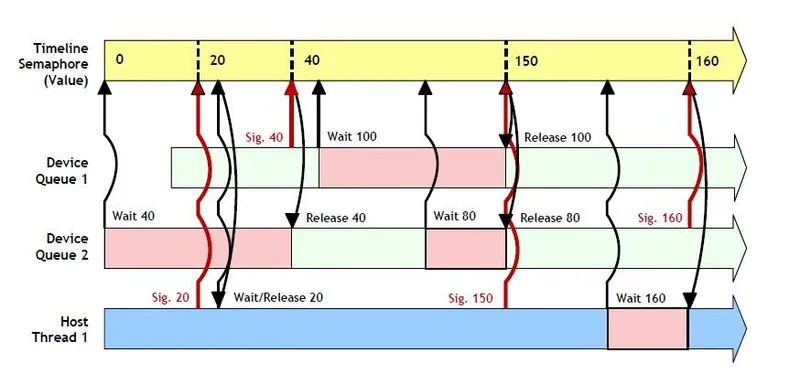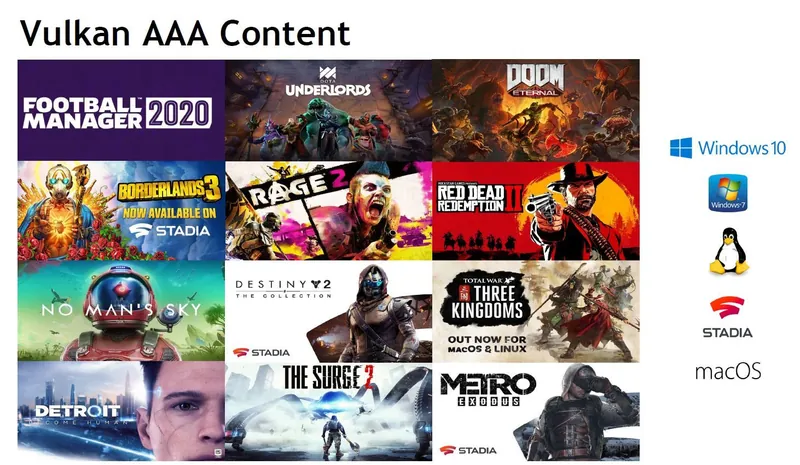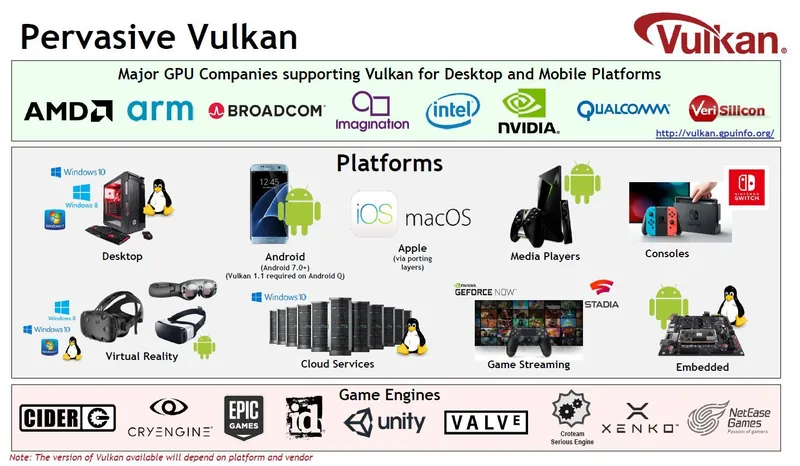Today, The Khronos® Group, an open consortium of industry-leading companies creating advanced interoperability standards, announces the release of the Vulkan® 1.2 specification for GPU acceleration. This release integrates 23 proven extensions into the core Vulkan API, bringing significant developer-requested access to new hardware functionality, improved application performance, and enhanced API usability. Multiple GPU vendors have certified conformant implementations, and significant open source tooling is expected during January 2020. For more information, go to the Vulkan Resource Page.
Vulkan continues to evolve by listening to developer needs, shipping new functionality as extensions, and then consolidating extensions that receive positive developer feedback into a unified core API specification. Carefully selected API features are made optional to enable market-focused implementations. Many Vulkan 1.2 features were requested by developers to meet critical needs in their engines and applications, including: timeline semaphores for easily managed synchronization; a formal memory model to precisely define the semantics of synchronization and memory operations in different threads; descriptor indexing to enable reuse of descriptor layouts by multiple shaders; deeper support for shaders written in HLSL, and more.

“Vulkan 1.2 brings together nearly two dozen high-priority features developed over the past two years into one, unified core Vulkan standard, setting a cutting-edge bar for functionality in the industry’s only open GPU API for cross-platform 3D and compute acceleration,” said Tom Olson, distinguished engineer at Arm, and Vulkan working group chair. “Khronos will continue delivering regular Vulkan ecosystem updates with this proven, developer-focused methodology to both meet the needs and expand the horizons of real-world applications.”
Khronos and the Vulkan community will support Vulkan 1.2 in a wide range of open source compilers, tools, and debuggers by the end of January 2020. This includes the RenderDoc frame capture and debugging tool, the Vulkan conformance test suite, and the Vulkan SDK with support for both the ‘GPU Assisted’ and ‘Best Practices’ validation layers.
All GPUs that support previous versions of Vulkan are capable of supporting Vulkan 1.2, ensuring its widespread availability. As of today, five GPU vendors have Vulkan 1.2 implementations passing the Khronos conformance tests: AMD, Arm, Imagination Technologies, Intel, NVIDIA, plus the open-source Mesa RADV driver for AMD. Driver release updates will be posted on the Vulkan Public Release Tracker along with the status of other Vulkan ecosystem components.
Vulkan is an open, royalty-free API for high-efficiency, cross-platform access to modern GPUs, with widespread adoption in leading engines, cutting-edge games, and demanding applications. Vulkan is supported in a diverse range of devices from Windows and Linux PCs, consoles, and the cloud, to mobile phones and embedded platforms, including the addition of Google’s Stadia in 2019.
Find more information on the Vulkan 1.2 specification and associated tests and tools at Khronos’ Vulkan Resource Page. Sample code can be found in the Vulkan Unified Samples Repository. Khronos welcomes feedback on Vulkan 1.2 from the developer community through Khronos Developer Slack and GitHub.

Industry Support for Vulkan 1.2
“AMD is excited to provide support for the Vulkan 1.2 specification in our upcoming Vulkan 1.2 supported driver for a broad range of AMD graphics hardware, including the AMD Radeon™ RX 5700 Series and AMD Radeon™ RX 5500 Series. Vulkan 1.2 brings many new features, including Dynamic Descriptor Indexing and finer type support for 16-bit and 8-bit types – and are designed to enable developers to better take advantage of modern GPU features and deliver richer graphics experiences to end users. We look forward to continued adoption of the Vulkan API and the new graphics experiences possible with the latest Vulkan 1.2 feature set,” said Andrej Zdravkovic, corporate vice president, software development, AMD.
“Imagination welcomes the launch of Vulkan 1.2. It’s a great update and will really benefit developers. Our latest GPU architecture – IMG A-Series – will fully support Vulkan 1.2 and will help developers achieve the best performance and power savings. Our best-in-class tools, such as PVRTune and PVRCarbon, are designed with Vulkan in mind, giving developers detailed information of profiling and debugging,” said Mark Butler, vice president of software engineering, Imagination Technologies.
“NVIDIA’s Vulkan 1.2 drivers are available today with full functionality for both Windows and Linux,” said Dwight Diercks, senior vice president of software engineering, NVIDIA. “With Vulkan enabling mission-critical applications on NVIDIA GPUs across desktop, embedded and cloud platforms, we’re driving innovative functionality to fuel the growing momentum of this key open standard.”
"We are very excited about the new capabilities in Vulkan 1.2. The VMA and scheduling features allow us to implement next-generation graphical and computing solutions across a wide array of hardware for our Cider game engine," said Brad Wardell, CEO of Stardock Entertainment.

More Information
More information on Vulkan is available at https://www.khronos.org/vulkan/
All Khronos open source projects are available here: https://github.com/KhronosGroup
A tutorial on Vulkan Timeline Semaphore is available here: https://khr.io/t5
To get an update on HLSL support in Vulkan please visit: https://khr.io/t7

